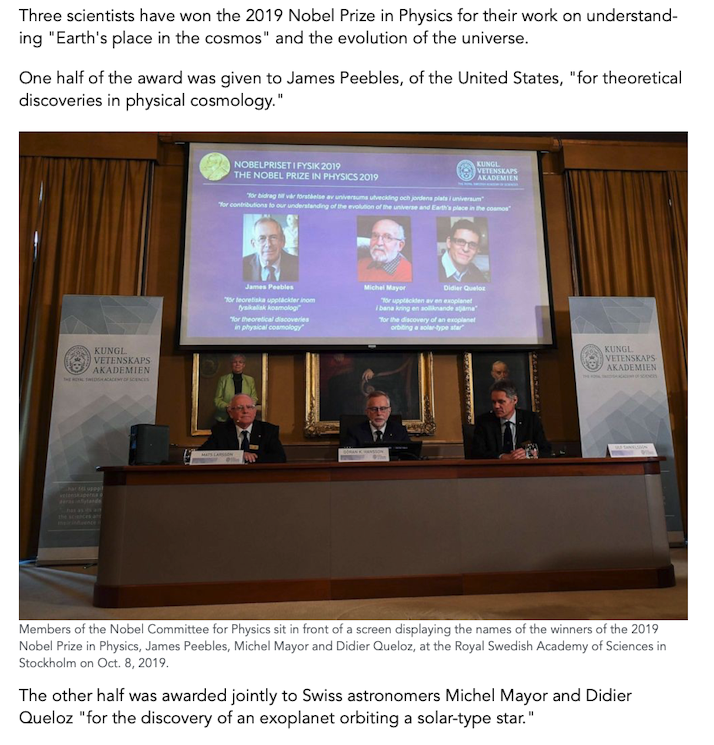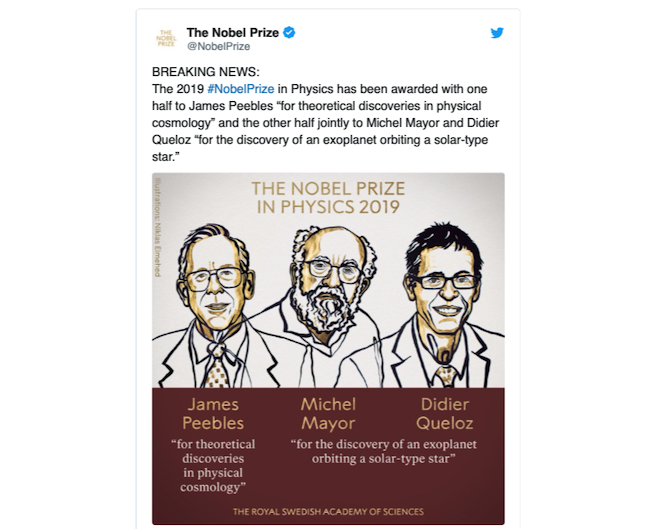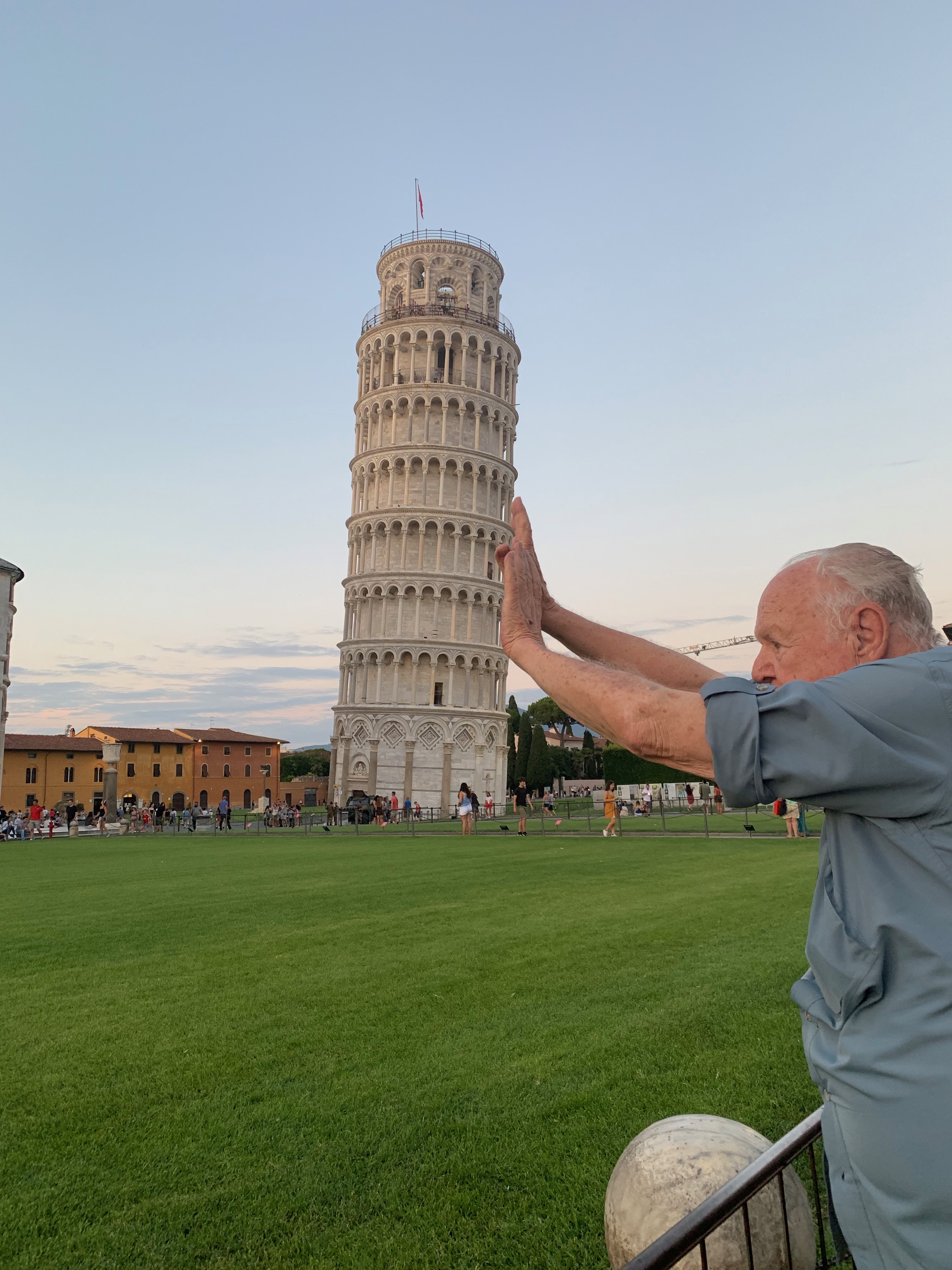
(MORE: Nobel Prize for Medicine awarded to 3 scientists)
The three men will share a 9-million kronor ($918,000) award, a gold medal and a diploma that the laureates will receive at a ceremony in Stockholm on Dec. 10.

Their work helps us better understand how the universe was formed and what it’s made of, changing how we understand the universe.
In particular, Peebles’ theoretical framework, which formed the basis of our modern-day ideas about the universe, enriched the field of cosmology at large, transforming it from “from speculation to science,” according to the Royal Swedish Academy of Sciences, which awarded the prize.
(MORE: 3 win Nobel Prize for showing how cells sense low oxygen )
Last year’s Nobel Prize in Physics was awarded to Donna Strickland of Canada, Arthur Ashkin of the United States and Gerard Mourou of France, for their work on harnessing laser light, which led to the invention of Lasik eye surgery. Strickland was the third woman in history awarded the Nobel Prize in Physics.
Nobel prizes in chemistry and literature will continue to be announced this week, with the most famous prize, the Nobel Peace Prize, announced Friday.
Here are some gems from the New Scientist archive about their achievements:
Writing in 2014, Jim Peebles recalls the discovery of the cosmic microwave background 50 years earlier, which confirmed the big bang story of the universe’s birth
FIFTY years ago, on 20 May 1964, Arno Penzias and Robert Wilson of the Bell Telephone Laboratories in Holmdel, New Jersey, recorded their first astronomical measurements of microwave radiation from the supernova remnant Cassiopeia A. They were using a horn antenna system first assembled in 1959 to study microwave communication – an early step in the development of today’s cellphone technology.
The antenna had been carefully engineered to reject radiation from the ground. But once all known sources in the sky had been painstakingly accounted for, Penzias and Wilson were left with the same problem that had been bothering Bell’s engineers. The microwave sky seemed to be about 2 degrees warmer than anyone expected.
At the time, I was a young theorist just down the road in the physics department at Princeton University, in the research group of Bob Dicke. Bob was a fan of the idea that the universe began in a hot, dense state – a big bang. One idea he was exploring was that a big bang should have left behind a sea of radiation uniformly spread across the sky. Bob had set two members of his group, Peter Roll and David Wilkinson, onto building a receiver capable of detecting this radiation, and suggested I look into the theoretical consequences of detecting or not detecting it.
The following February I presented the idea of our search in a colloquium. A few weeks later, Bob received a phone call from Penzias. A subsequent visit to Holmdel by Bob, Peter and David convinced us that we had been scooped. The universe’s origin had been discovered as an unintended consequence of a communications engineering project.
Looking back from the distance of a half-century, it is easy to forget that, back then, many physicists dismissed any investigations into how it all began as empty speculation. The sea of noise that was so troubling to Penzias and Wilson is the cosmic microwave background (CMB), which is now known to be clinching evidence for a big bang. But it wasn’t immediately seen that way, as a glance back through the pages of New Scientist shows. In 1976 Martin Rees, then recently elected to the illustrious Plumian professorship of astronomy at the University of Cambridge, writes that “no plausible alternative theory” could account for the CMB’s observed characteristics (2 December 1976, p 512). Yet five years later, Rees’s Plumian predecessor Fred Hoyle still sees a chance for the rival steady state theory, writing that the latest CMB measurements “differ by so much from what theory would suggest as to kill the big-bang cosmologies” (19 November 1981, p 521).
Radiation resolution
The big bang and steady state theories both have their origin in the discovery in the 1920s that distant galaxies are moving away from us, as if the universe were expanding. The big bang theory, developed in the ensuing decades, postulates that everything here now was also there back then, so the universe must be expanding from a denser early state. The steady state theory, which Hoyle co-devised in 1948, suggests instead that matter is continually created in the expanding universe, with new galaxies forming to fill the spaces that open up as already existing ones move apart. In this picture, the universe’s past was no hotter or denser than its present.
Something like a CMB crops up in some of the earliest considerations of what a hot, dense early universe would have looked like. In the late 1930s, attempts to explain the relative abundances of the chemical elements – why is there so much more iron than gold, for instance? – included the proposal that the heat of the early universe produced violent collisions that thoroughly rearranged the neutrons and protons within atomic nuclei. These analyses implicitly assumed a sea of surrounding radiation hot enough to promote the right sort of reactions. This sea would have slowly cooled as the universe expanded.
George Gamow and his graduate student Ralph Alpher didn’t mention this thermal radiation when they presented their famous paper on big-bang elemental abundances in 1948 – a paper celebrated both for its content and Gamow’s unsolicited introduction of the physicist Hans Bethe on to the author list, so it would approximate the first three letters of the Greek alphabet, alpha, beta, gamma. Their analysis, it turned out, also conflicted with known rates of nuclear reactions from weapons research during the second world war. A few months later Gamow redid the analysis, removing the conflict by adding in the sea of thermal radiation. He realised that the radiation would still be present, but he was silent about how hot it might be. Alpher, with Robert Herman, supplied a figure, arriving at a temperature of about 5 kelvin.
Gamow’s analysis incurred Hoyle’s displeasure, both because it ignored the steady-state cosmology and because it produced an abundance of helium of about 30 per cent of the total cosmic mass, far higher than observations could at the time support. When, by the early 1960s, improved evidence suggested this figure is in fact about right, Hoyle was one of the first to note that it fits the big bang cosmology – but he took care to suggest that it might instead have come from explosions of supermassive stars, little bangs in a steady-state universe.
This is kind of where we were in 1964. Bob was taken by the idea that an expanding big-bang universe might have bounced back after a previous cycle of expansion had collapsed. During such a collapse, starlight would be compressed along with the matter, reaching temperatures and densities high enough to pull apart the heavy elements produced by stars in the last cycle and so provide new nuclear fuel for our cycle. This process would cause the radiation to reach thermodynamic equilibrium, with the same temperature everywhere, producing a characteristic spectrum of intensities at different wavelengths known as a thermal Planck spectrum – a sure sign of our universe’s origin in a hot, dense state.
Bob also knew microwaves. As part of the effort to develop shorter-wavelength radar with better resolution during the second world war, he had invented a microwave detector that was used to study radiation absorption and emission by atmospheric water vapour. As a sideline, he had written a paper in 1946 on the upper limits of cosmic microwave radiation. The experiments were done in Florida, whose muggy nights supplied ample atmospheric water to flood the detector with microwaves. Had they happened on a cold, dry winter’s night in Princeton, Bob might have been the first to detect the CMB.
But people can be forgetful, and in 1964 we had to remind him that he had even set a limit. He also told us he had vague memories of hearing a lecture by Gamow, though not what it was about. But perhaps echoes of Gamow’s thoughts, along with the Florida tests, were driving Bob’s thinking in 1964. In the 1981 New Scientist article, Hoyle recalls a conversation he had with Bob in 1961 about the behaviour of interstellar CN, a molecule that rotates as if it were immersed in microwaves at about 2.3 kelvin. Bob certainly didn’t remember that discussion, for it would have been quite out of character for him not to tell us, but this indication that the CMB might exist may also have been lurking in the back of his mind.
I suppose “back of the mind” is as good a way as any to account for the sudden disruptions of orderly research by surprising and exciting ideas. That unexpected, even unwanted, measurements – an annoying hiss in a glorified telecommunications antenna – on occasion prove to be wonderfully informative is just one of the ways science advances.
Proved beyond doubt
I don’t remember any expression of regret by Bob or any of us at being scooped. Instead, there was excitement that something was there to be measured and analysed. Early on, our focus was on finding out whether the CMB did indeed have that telltale Planck spectrum. In the 1970s, this was still sufficiently disputed to support the differing interpretations put forth in Rees’s and Hoyle’s articles.
“I recall no regret at being scooped – just excitement at something to measure”
Roll and Wilkinson’s experiment soon added another data point, and Wilkinson eventually added many more, culminating in his leading role in the COBE satellite mission that in the early 1990s finally showed the CMB spectrum is close to a Planck form with a temperature of around 2.73 kelvin. (Herb Gush at the University of British Columbia, Canada, whose rocket-based experiment confirmed it one month later, might have scooped this finding, had it not been for launch delays.)
Few apart from Hoyle and his close associates doubted the universe’s origin in a big bang by then. Penzias and Wilson had received a share of a Nobel prize in 1978, which is fair enough: they tracked down every conceivable terrestrial source of excess microwave radiation, and complained about their inability to account for the anomaly until someone at last paid attention. But Bob ought to have shared it, both for inventing much of the technology used to discover the CMB, and for proposing the search that led the Bell researchers to recognise they had already found it.
Meanwhile, my own theoretical thinking started down the road Gamow pioneered, but I kept seeing new things to do. The CMB would be disturbed by the gravitational attraction of matter, which in our universe is now quite clumped up, and by interactions with matter in the form of plasma in the hot young universe. More accurate measurements of how much the CMB departs from uniformity, from Wilkinson and a growing list of colleagues, drove me to devise the now established ΛCDM cosmological model.
At the time I thought I was writing down a theory that involved disturbances to the microwave background too small to be detected. Thanks to COBE and its follow-up missions, however – NASA’s WMAP, the European Space Agency’s Planck probe, and a host of others – we now have precise measurements of how the CMB departs from an exactly uniform sea of radiation that inform us about the history of expansion of the universe and the nature of its material contents. I have written three books on the subject, each much larger than the last. Now the field has grown much too big for a monograph; it is richer by far than anything I imagined when I started following Bob’s suggestion a half-century ago.
With ΛCDM, we now have an excellent fit of cosmological theory and measurements, albeit one that requires two hypothetical components: unseen cold dark matter – the CDM – to keep galaxies clumped together, and the cosmological constant, lambda (Λ). This constant is the quantity Einstein introduced into his equations of relativity to create a static universe, and then regretted as an inelegant and unneeded complication. Now it is needed to account for the accelerated expansion of the universe revealed by measurements of far-off supernovae, and also for details of the distribution of the CMB. Its new name, “dark energy“, isn’t a sign of progress: we still don’t understand its nature.
Not least because of these two hypothetical interlopers, caution is in order. The fit of the ΛCDM cosmological model also depends on an optimistic extrapolation of general relativity from the largest tested scale of the solar system to the vastly bigger scale of the observable universe. But tests from the CMB and elsewhere are abundant enough now that I am forced to conclude that we have a convincing approximation to what happened as the universe expanded and cooled.
An elegant theory
Hoyle’s steady-state cosmology is quite convincingly ruled out, although its philosophy reappears in the concept of the multiverse – the idea that universes like the one we live in are constantly budding out of some greater universe. The theory of eternal inflation, where this idea arises, postulates that our universe underwent a period of enormously accelerated expansion in its earliest instants, and offers an elegant way to understand what happened before the expanding universe had cooled to the point that it can be described by Einstein’s general relativity.
The patterns by which the CMB’s temperature deviates from uniformity over different distance scales matches what might be expected in a simple mathematical formulation of inflation, although the fit is not unambiguous. The recent discovery of polarisation patterns in the CMB by the BICEP2 experiment in Antarctica has been interpreted as the first definitive observational evidence for inflation, although many remain to be convinced that the polarising effect isn’t a result of dust and electrons in the Milky Way’s magnetic field (26 April, p 32).
However that story pans out, cosmology has matured beyond all recognition in a century. In 1914, Einstein was putting the finishing touches to general relativity, the theory on which it is all based. Today, ever more detailed explorations of the CMB could be taking us back to a universe even beyond general relativity. But a crucial way station was reached precisely 50 years ago: the identification of an unexpected hiss that tells the story of the universe’s origin.
Key figures
Robert (Bob) Dicke (1916-1997) A wide-ranging physicist who, besides his contributions to microwave physics, worked in laser and atomic physics, and developed precision tests of Einstein’s theory of general relativity.
George Gamow (1904-1968) A Russian-born US cosmologist who was an early champion of the big bang theory, he also made pioneering contributions to the fields of nuclear physics and molecular genetics. Gamow is also remembered for his Mr Tompkins series of popular-science books.
Fred Hoyle (1915-2001) A British theoretical astronomer who played an important part in explaining the physics of stars and challenging ideas about an evolving universe. A champion of the steady-state universe theory, he coined the term “big bang” as a disparaging reference to its rival.
Robert Wilson (1936- ) and Arno Penzias (1933- ) The Bell labs duo shared the 1978 Nobel prize in physics for their demonstration, published in 1965, that Bell’s microwave antenna had detected what proved to be the cosmic microwave background (CMB).
David Wilkinson (1935-2002) A cosmologist whose seminal
contributions to CMB measurements were honoured with the naming of
NASA’s Wilkinson Microwave Anisotropy Probe, which was launched in 2001.
Read more: https://www.newscientist.com/article/mg22229690-500-i-was-there-at-the-birth-of-the-big-bang/#ixzz61yUzeTTW
